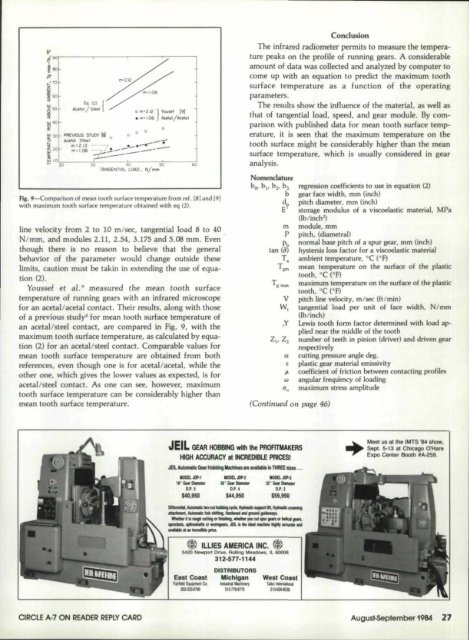Download the August/September 1984 Issue in PDF format - Gear ...
Download the August/September 1984 Issue in PDF format - Gear ...
Download the August/September 1984 Issue in PDF format - Gear ...
You also want an ePaper? Increase the reach of your titles
YUMPU automatically turns print PDFs into web optimized ePapers that Google loves.
... ~------.-------.------.~----~<br />
,,""212 } You.. ' [91<br />
• 'm"06 _ol/Acolo'<br />
FIg. 9'-COmI'Mison of mean tooth surface temperature from ~ef. lSI and 191<br />
with maximum tooth surfac temperature obta<strong>in</strong>ed with eq (2).<br />
l<strong>in</strong>e v@locity from. 2 to )0 m/sec, tangential load 8 to 40<br />
Nlmm, and modules 2.11. 2.54. 3.175 and 5 ..08 mm. Even<br />
though <strong>the</strong>re is no reason to believe tha'l <strong>the</strong> general<br />
behavior of <strong>the</strong> parameter would ,change outside <strong>the</strong>se<br />
limits, caution must be tak<strong>in</strong> <strong>in</strong> extend<strong>in</strong>g <strong>the</strong> use of equation<br />
(2,.<br />
Youssef et at q measured <strong>the</strong> mean tooth suriece<br />
temperature of runn<strong>in</strong>g gears with an <strong>in</strong>frared microscope<br />
for an acetal/acetal, contact. Their results, along with those<br />
of a. previous study' for mean 'tooth surface temperature of<br />
an acetal/steel contact, are compared <strong>in</strong> Fig. 9, with <strong>the</strong><br />
maximum tooth surface temperature, as calculated by equation<br />
{2) for an acetal/steel contact. Comp'3xable values for<br />
mean tooth surface temperature are obta<strong>in</strong>ed fllom both<br />
references. even though one is for acetal/acetal. whil.e th<br />
oth r one, which gives <strong>the</strong> lower values as expected, is for<br />
acetal/steel contact. As one can see, however, maximum<br />
tooth surface temperature can be eonsiderably higher than<br />
mean tooth surface temperature.<br />
D<br />
'Condusian<br />
The <strong>in</strong>frared radiemeter permits to measure <strong>the</strong> temperature<br />
peaks on <strong>the</strong> profile of runn<strong>in</strong>g gears. A considerable<br />
amount of data was collected and analyzed by computer to<br />
come up wilh an equation to predict '<strong>the</strong> maximum tooth<br />
surface temperature as a function of <strong>the</strong> operat<strong>in</strong>g<br />
parameters ..<br />
The results show <strong>the</strong> <strong>in</strong>fluence of <strong>the</strong> material, as well as<br />
that of tangential load, speed, and gear module. By comparison<br />
with published data for mean tooth surface temperature,<br />
it is seen that I<strong>the</strong> maximum temperature en '<strong>the</strong><br />
tooth surface might be considerably higher than <strong>the</strong> mean<br />
surface temperature, which is usually considered <strong>in</strong> gear<br />
anaJ:ysis,<br />
No:~mh,ture<br />
boo "" b2, bl<br />
b<br />
m<br />
p<br />
pc<br />
tan (a~<br />
T.<br />
TID'<br />
(Cont<strong>in</strong>ued on page 46)<br />
~on coefficients 110 use .<strong>in</strong> equation (2)<br />
gear face width. mm (<strong>in</strong>ch)'<br />
pitch diameter, mm (im:h)<br />
storage modulus ofa viscoelastic material, MPa<br />
Oh/<strong>in</strong>ch l )<br />
moduJ, mm<br />
pitch, (diametraI)<br />
normal base pitch of a spur gear, mm (<strong>in</strong>ch)<br />
hystersis loss fad·orf,oraviscoelas:tic material<br />
ambient temperature, °C ("F)<br />
mean temperatun: en <strong>the</strong> surface of <strong>the</strong> plastic<br />
tooth. DC (OF)<br />
maximum temperature on til-urEa e of th plastic<br />
tooth, °C (OF)<br />
pitch l<strong>in</strong>e velocity, m/sec (Ft/m<strong>in</strong>)<br />
tangential load per unit of faoe width, N/mm,<br />
(lblim:h)<br />
lewis tooth form factor d tcrm<strong>in</strong>ed with load applied<br />
near<strong>the</strong> middle of <strong>the</strong> tooth<br />
number of t,eethLnp<strong>in</strong>ion (drivee) and driven gear<br />
~pective:ly<br />
,cutt<strong>in</strong>g pressuxe angle deg.<br />
plastic gear material emi.ssivity<br />
,coefficient of :friction between contact<strong>in</strong>g pmfiles<br />
angular frequency of load<strong>in</strong>g<br />
maximum stress amplitude<br />
,JElL GEAR IMOBBING,with <strong>the</strong>, PROA'I\tAKEml<br />
IHIGH ACCURACY at INCREDIBlE PRICESI<br />
.1<br />
'&'.AIII-- . GNr IiIIIII*Ig 1IIiI:tl1t:t .......... lilfIIREE 1izII ••.<br />
'1·'IiIII' ......<br />
IDJ' 5<br />
MII.9S01<br />
1IIDl..r:N<br />
,a'liIII'~<br />
0,". ~<br />
1",950<br />
IOOB.JlN<br />
'!tI:.IiIII'~<br />
D.P. ,<br />
IS9.9SO<br />
+ -Meel us a1 U1 IMIS '84 , 'how,<br />
Sep!. 5-13 at.Chlcago .o'Hare<br />
E~po Center lBooth, 'A-2S9.<br />
E& 1Cout<br />
f.tiII e-w, Co.<br />
3DmOl!IQ<br />
DISTRIIBUTORS<br />
Michigan<br />
IillllNlIiIKiwwy<br />
31l·f1I.ITIIJ<br />
West t __ Coast<br />
213

















